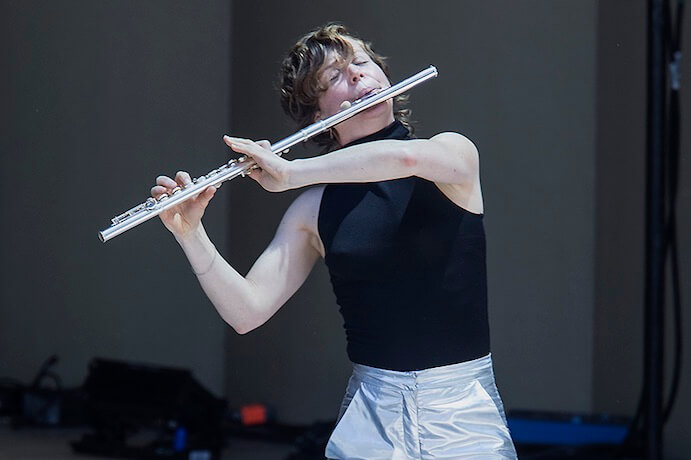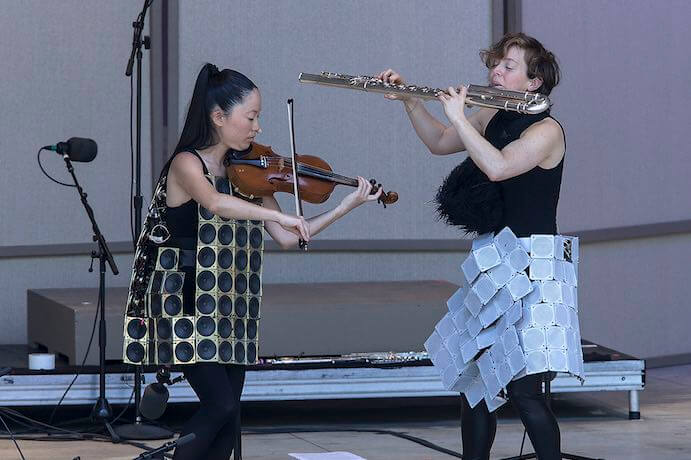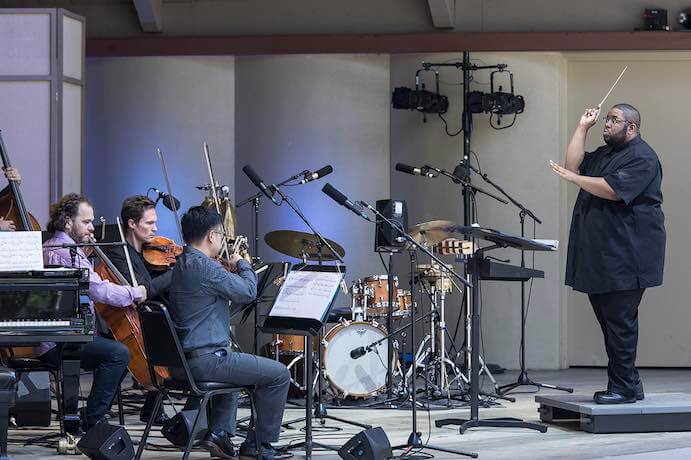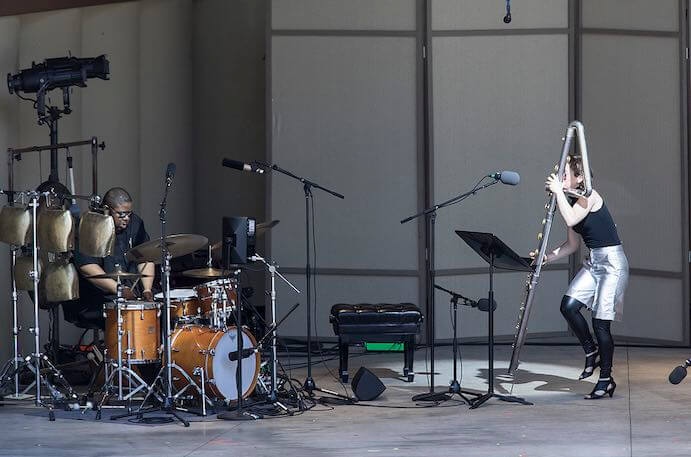The flute unfolded itself into kaleidoscope of characters and sounds in the hands of Claire Chase on Friday, June 9, 2017 at the Ojai Music Festival. Performing Part IV of her Density 2036 project, Chase highlighted works that expose the multifaceted nature of her instrument. It was seamless, thrilling, and ultimately entrancing.
Chase’s project takes its inspiration from pieces like the Bach Chaconne or the Rite of Spring that have given rise to a host of what Christopher Hailey (Ojai Festival writer) calls “works gyrating in their orbit,” inserting Edgar Varèse’s 1936 solo flute composition Density 21.5 into this canon. 80 years after Density’s publication, Chase has conceived a long-term commissioning project that culminates in the year of its centennial. What was seen on June 9th showcased just a quarter of Chase’s commissions towards this long-term project, and it’s no surprise there is no shortage of composers eager to write for her. Her technical command on flutes of all kinds–including the ocarina and the rarely-seen contrabass flute–would cause any composer’s imagination to run wild. But beyond her supreme chops lies an uncompromising musicality that presents every piece in its rich, vivid detail. Dense, but in the rarely connoted visceral sense of the word.
Varèse’s Density 21.5 was so-called as a tribute to the platinum flute with a density of 21.5 grams, an engineering feat of his day. Chase opened the concert by ditching limiting historical notions of the flute as something “pretty” or “erotic,” opting instead for gravitas and foreshadowing what was to come. Perhaps due to the heaviness of the special instrument, Density 21.5 had a satisfying weight in its execution, as though it were 1936 again and Chase was just coming to terms with its newness. Over the course of a few minutes, Varèse’s intervallic scheme lifted us gradually higher and higher in a gracefully-woven otherworldly tapestry blasting itself away from earth to whence it came.

Density 21.5 with Claire Chase at Ojai Music Festival 2017–Photo by David Bazemore
Suzanne Farrin’s The Stimulus of Loss established the notion of background, or dialogue with another player. Chase now had the traveling companion of a recorded ondes martenot, an early electronic instrument that Varèse adopted in much of his other music. In Farrin’s piece, this keyboard-theremin hybrid hummed and swooped in warm and nasal tones, finding itself as a primary voice about three minutes in. A glissando headjoint, facilitating unimpeded slides on the keyed flute, added a layer of expressivity to Chase’s playing that the Varèse did not have.
Then came a rumble in the narrative, a threat to the peace of floating in space. Bertha’s Lair, a work by 36-year-old jazz-cum-avant-garde percussionist and composer Tyshawn Sorey, is scored for contrabass flute and the composer on drums. Split partials and key clicks made up Chase’s sound world, while Sorey’s gestural rhythms threw this world into a spiral and propelled it further and further from charted sonic territory. In Vijay Iyer’s Flute Goals (Five Empty Chambers), the composer showed himself to be not only a master of the piano and the English language, but also of the electronic beat, an invisible DJ processing Chase’s pre-recorded flute sounds into rhythms and faintly melodic snippets. Though Chase left the stage for this, it was nothing like an intermission. Most gripping of all were the rhythmic timbres, sourced from pitched flute and distorted into a unique sound of percussive wind. In this way, rhythm was not a bedrock to the piece, but part of a cycle–a novel way of approaching electronic composition in and of itself.

Pauchi Sasaki and Claire Chase at Ojai Music Festival 2017–Photo by David Bazemore
Gama XV, by violinist and mixed-media Peruvian composer Pauchi Sasaki, carves out yet another futuristic acoustic space that evoked a sudden stillness and a distinctly far-away feeling. Imagine an underwater cathedral with blindingly white walls and hushed tones coming from figures you can’t get too near to. As Sasaki and Chase moved through their slowly-unfolding and symmetrical choreography, they created subtle feedback effects with interactive “speaker dresses,” comprising 96 tiny speakers in total. As the background soundscape moved from the industrial–something along the lines of a tumble-dryer–to the natural–panned ocean waves–the flute held a place far, far from the Milky Way, among unseen stars.
In the program closer, an excerpt from Marcos Balter’s Pan, Chase finally established herself as a sun in a new solar system. Sitting at the helm of a circle of volunteers from the audience, ICE, and Oberlin CME, she invited this group of about thirty to strike up the (cosmic) band with her hands. While wine glasses, triangles, glass bottles and wood chimes evoked dust rings and rapidly forming planetary bodies, this was ultimately balanced by Chase’s world of mystic melodies that reminded us where we came from (Varèse). But the piece, replete with a flute vocoder tarantella and an animal-sounding processed contrabass flute, never lulled. Pan is 90-minutes in full, and while only one-third of it fit onto the program, its mystique and world-unto-itself ethos left me wanting to inhabit it just a little while longer.

The Inner Spectrum of Variables with Tyshawn Sorey (conductor)–Photo by David Bazemore.
The second half of the concert featured the Tyshawn Sorey Double Trio performing his recent work The Inner Spectrum of Variables, an uninterrupted four-movement piece that insists on the laws of acoustics for its very structure, constantly expanding and retracting like a sound wave. While the slow sections hummed along, they never bored, constantly searching and ecstatically finding new paths down which Sorey’s synthesis of disparate musical styles–jazz, classical, avant-garde, improvisation, even Ethiopian and klezmer–would prove periodically fruitful. I did wonder, though, if the piece would have worked better in a small enclosed room rather than in Libbey Bowl’s electronically-reinforced acoustic. I even considered whether it would have worked better for just piano and drums, providing univocal clarity for the pitch material against Sorey’s unpredictable rushes of percussive energy. Perhaps, like Chase’s Density, Sorey’s Inner Spectrum is sending out pulses into the ether in search of a new home. It was adamantly unlike anything I had ever heard before, and for that alone I was moved.





















